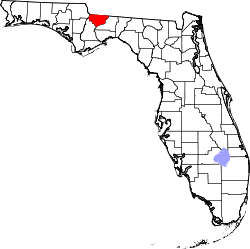Quincy, Florida
| Quincy, Florida | |
|---|---|
| City | |
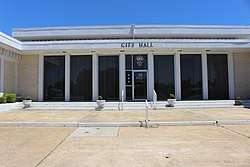 Quincy City Hall | |
| Motto(s): "...In the heart of Florida's future"[1] | |
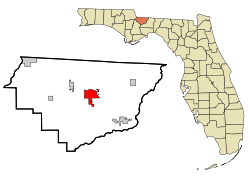 Location in Gadsden County and the state of Florida | |
 Quincy, Florida Location in the United States | |
| Coordinates: 30°35′N 84°35′W / 30.583°N 84.583°WCoordinates: 30°35′N 84°35′W / 30.583°N 84.583°W | |
| Country | United States |
| State | Florida |
| County | Gadsden |
| Area[2] | |
| • Total | 11.61 sq mi (30.08 km2) |
| • Land | 11.60 sq mi (30.04 km2) |
| • Water | 0.01 sq mi (0.04 km2) |
| Elevation | 207 ft (63 m) |
| Population (2010) | |
| • Total | 7,972 |
| • Estimate (2016)[3] | 7,680 |
| • Density | 662.07/sq mi (255.63/km2) |
| Time zone | UTC-5 (Eastern (EST)) |
| • Summer (DST) | UTC-4 (EDT) |
| ZIP codes | 32351-32353 |
| Area code(s) | 850 |
| FIPS code | 12-59325[4] |
| GNIS feature ID | 0289404[5] |
| Website |
www |
Quincy is a city in Gadsden County, Florida, United States. The population was 7,972 at the 2010 census,[6] up from 6,982 at the 2000 census. It is the county seat of Gadsden County.[7][8]
Quincy is part of the Tallahassee, Florida Metropolitan Statistical Area.
History
Established in 1828, Quincy is the county seat of Gadsden County, and was named for John Quincy Adams.[8] It is located 25 miles (40 km) northwest of Tallahassee, the state capital. Quincy was once heavily dependent upon agriculture, farming tomatoes, tobacco, mushrooms, soybeans and other crops for its employment base.
Tobacco
In 1828, Governor William P. Duval introduced Cuban tobacco to the territory of Florida. As a result, the culture of shade-grown cigar wrapper tobacco was a dominant factor in the social and economic development of Gadsden County. Tobacco is a native plant of the western hemisphere. Early European explorers discovered Native Americans growing the plant when they set foot on their soil.
In 1829, John Smith migrated to Gadsden County in covered wagons with his family and four related families. Since there was already a resident named John Smith in the community, he became known as John "Virginia" Smith. When Smith ventured southward he brought with him a type of tobacco seed which was used for chewing and pipe smoking. He planted that seed and found that the plants grew vigorously. Because there was no market for tobacco in small quantities, it was twisted together, cured and shared with his friends. He purchased some Cuban tobacco seed and planted them with his Virginia tobacco. Several years passed and the two tobaccos blended.
When the Virginia tobacco was grown in Florida soil, it was much thinner and lighter in color. Smith began saving the seed from the hybridized stalks. From these seeds, a new plant known as "Florida Wrapper" was developed. So began a tobacco industry at a time when the South was suffering from the low price of cotton.
Growing tobacco continued to be profitable until the beginning of the Civil War in 1861, even when the European markets were no longer available. Of course, during the war and the Reconstruction Era, very little tobacco was grown except for personal use. Those days were tremendously difficult, and recovery was a slow process. The post-war search for a money crop led to the resurgence of the tobacco culture. Through these experiments it was discovered that tobacco which was light in color and silky in texture demanded the highest prices. So, with more experimentation, shading the plants began. At first, wood slats were used, but these proved too heavy. Then they tried slats draped with cheese cloth to keep the plants from the light. Next came ribbed cheese cloth. Ultimately in 1950, the white cheese cloth was replaced with a treated, longer lasting, yellow cloth that provided perfect shade.
Colonel Henry DuVal, president of the Florida Central and Peninsular Railroad, shipped samples of Gadsden County tobacco to New York for leaf dealers and cigar manufacturers to inspect. Soon representatives of several companies came down from New York to purchase land for growing tobacco. There was such an influx of land purchases that a number of packing houses arose. This continued until 1970 when tobacco companies came under fire and demand diminished. Around 1970, growing tobacco declined substantially in Gadsden. The development of a homogenized cigar wrapper, the ever-increasing cost of production, the subsidizing of the tobacco culture in Central America by the U.S. government, and the increasing, negative legal climate against the tobacco industry have added to the demise of Gadsden's future in tobacco. The last crop of shade-grown cigar wrapper tobacco was grown in 1977.
Quincy then turned to its other crops, tomato, mushroom and egg farms. This continued until the close of Quincy's mushroom factory and massive layoff of workers at Quincy's tomato farm in 2008. Quincy now turns to its businesses and is attempting to build itself into a business-based district.[9]
Race Relations
Lynching
In 1911, A. C. Williams was accused of robbery and the attempted rape of a 12 year old white girl. The account of the details makes the accusation very improbable, but Williams did not live long enough to be tried for the crime. He was kidnapped from jail by a group of white men, and although they both shot him and hanged him, Williams survived. After learning he was alive, the sheriff formed a search party. His family was aware the sheriff had been involved in the lynching, and hid him. Unfortunately, Williams needed medical attention and since the hospitals in the Quincy area would not treat a black person, he needed to be transported to Florida A & M University in Tallahassee. The following day a group of masked men kidnapped him from the ambulance and killed him. His body was dumped on his mothers porch.[10][11]
Resistance to Jim Crow
In the 1920s, blacks in Quincy including A. I. Dixie repeatedly tried to form political organizations and vote, and protest brutal labor conditions, but were suppressed by violence from whites. Dixie was flogged repeatedly for his efforts. Later, in 1964 Dixie's hosted CORE student activists, while his daughter Linda organized a sit-in, and Jewell Dixie became the first African American to run for Gadsden County Sheriff.[12][13]
All American City
In 1996, Quincy was recognized as an All American City.[14]
Essence article
In February 2003, an article in Essence magazine stated that Quincy was the city with the most AIDS cases in Florida.[15] Some residents of the city were upset with the negative publicity.[15][16] "Quincy has no more AIDS cases than typical rural cities in Florida", the mayor, Keith Dowdell, stated, and the city with the highest amount of AIDS cases in Florida in 2003 was Palm Beach, not Quincy. The article claimed that African-American females represented 90% of AIDS cases in Quincy,[17] although the highest percentage of AIDS cases in Quincy at that time was in males.[18] Essence article In February, 2003 Essence Magazine incorrectly wrote to its over 3 million users that Quincy was the city with the most AIDS cases in Florida. This caused problems with the citizens and mayor of Quincy. Of the over 14 medical doctors in the small city at the time, only one was interviewed.[11] and of the over 100 community leaders in Quincy, only one was interviewed. The writers of Essence also interviewed people in the back of a liquor store to represent the "citizens" of Quincy. This led to many lawsuits, including one from the owners of the store who stated that they had no idea Essence was doing an interview with their intoxicated patrons. Despite this, the negative stigma over the city still looms today.[12] "Quincy has no more aids cases than typical rural cities in Florida", the mayor, Keith Dowdell, stated and the city with the highest amount of Aids cases in Florida in 2003 was Palm Beach,Florida not Quincy. The article also misrepresented African- American females saying they represented 90% of Aids cases in Quincy. The highest percentage of Aids cases in Quincy at that time was in males[13] No official apology from Essence for the misleading and incorrect information was ever released.
The positive thing about the article was that it shined a light on Hiv/Aids as a major epidemic in Florida and led to many people researching to help those infected. Here are some 2003 facts about people with Aids in Florida in 2003. As of 2013 Miami Dade still ranked #1 in Hiv/Aids cases, not Quincy.
At the end of 2003, CDC estimated that ~1,185,000 persons in the U.S. were living with HIV/AIDS.
More than 40,000 HIV/AIDS cases are diagnosed in the U.S. each year.
More than 4,000 HIV/AIDS cases are diagnosed in Florida alone every year.
Florida is the 3rd state with the highest number of HIV/AIDS cases in the U.S. (After New York and California).
Broward County ranks 2nd in the number of HIV/AIDS cases in Florida (After Miami Dade County).
Source: Bureau of HIV/AIDS Florida Department of Health. Presentation by Spencer Lieb, Senior Epidemiologist.
Unequal Impact of HIV/AIDS in Minorities in Florida Data of 2004 show that blacks are over-represented among the AIDS cases, accounting for 53% of adult cases, but only 14% of the adult population. A group is disproportionately impacted to the extent that the percentage of cases exceeds the percentage of population.
Other includes Asian/Pacific Islanders and Native Alaskans/American Indians Source: Bureau of HIV/AIDS Florida Department of Health. Presentation by Spencer Lieb, Senior Epidemiologist.
In 2004, black males were 3.1 times as likely as white males to be reported with AIDS. The AIDS case rate among black females was 22 times higher than among white females. Hispanic disparities are less pronounced. Source: Bureau of HIV/AIDS Florida Department of Health. Presentation by Spencer Lieb, Senior Epidemiologist. It is estimated that in Broward, approximately 1 in 130 is living with HIV/AIDS 1 in 216 Whites; 1 in 50 Blacks and 1 in 198 Hispanics. Males account for 75% of AIDS cases, while females account for 25%.[14] Other references to the Aids cases in Gadsden county (of which Quincy is the head seat) include reports from the center for disease control [15] These reports are updated yearly. For more information on AIDS or HIV in Gadsden County and what is being done about it, please contact their Health Department.
Geography
Quincy is located in central Gadsden County at 30°35′N 84°35′W / 30.583°N 84.583°W (30.59, -84.58),[19] in the rolling hills of North Florida.
According to the United States Census Bureau, the city has a total area of 7.9 square miles (20.5 km2), of which 0.02 square miles (0.04 km2), or 0.18%, is water.[6]
Climate
| Climate data for Quincy | |||||||||||||
|---|---|---|---|---|---|---|---|---|---|---|---|---|---|
| Month | Jan | Feb | Mar | Apr | May | Jun | Jul | Aug | Sep | Oct | Nov | Dec | Year |
| Average high °F (°C) | 64 (18) |
67 (19) |
74 (23) |
79 (26) |
86 (30) |
90 (32) |
91 (33) |
90 (32) |
88 (31) |
81 (27) |
73 (23) |
66 (19) |
79 (26) |
| Average low °F (°C) | 40 (4) |
42 (6) |
48 (9) |
52 (11) |
61 (16) |
68 (20) |
71 (22) |
70 (21) |
66 (19) |
57 (14) |
49 (9) |
42 (6) |
56 (13) |
| Average precipitation inches (mm) | 4.80 (121.9) |
4.92 (125) |
5.86 (148.8) |
3.68 (93.5) |
5.04 (128) |
5.92 (150.4) |
7.36 (186.9) |
6.78 (172.2) |
4.15 (105.4) |
4.11 (104.4) |
3.51 (89.2) |
3.77 (95.8) |
59.9 (1,521.5) |
| Source: Weatherbase[20] | |||||||||||||
Demographics
| Historical population | |||
|---|---|---|---|
| Census | Pop. | %± | |
| 1870 | 743 | — | |
| 1880 | 639 | −14.0% | |
| 1890 | 681 | 6.6% | |
| 1900 | 847 | 24.4% | |
| 1910 | 3,204 | 278.3% | |
| 1920 | 3,118 | −2.7% | |
| 1930 | 3,788 | 21.5% | |
| 1940 | 3,888 | 2.6% | |
| 1950 | 6,505 | 67.3% | |
| 1960 | 8,874 | 36.4% | |
| 1970 | 8,334 | −6.1% | |
| 1980 | 8,591 | 3.1% | |
| 1990 | 7,444 | −13.4% | |
| 2000 | 6,982 | −6.2% | |
| 2010 | 7,972 | 14.2% | |
| Est. 2016 | 7,680 | [3] | −3.7% |
| U.S. Decennial Census[21] | |||
As of the census[4] of 2000, there were 6,982 people, 2,657 households, and 1,830 families residing in the city. The population density was 916.4 inhabitants per square mile (353.8/km²). There were 2,917 housing units at an average density of 382.9 per square mile (147.8/km²). The racial makeup of the city was 31.55% White, 64.15% African American, 0.16% Native American, 0.23% Asian, 3.22% from other races, and 0.69% from two or more races. Hispanic or Latino of any race were 6.89% of the population.
There were 2,657 households out of which 30.5% had children under the age of 18 living with them, 36.2% were married couples living together, 28.1% had a female householder with no husband present, and 31.1% were non-families. 27.9% of all households were made up of individuals and 14.1% had someone living alone who was 65 years of age or older. The average household size was 2.60 and the average family size was 3.17.
In the city, the population was spread out with 27.8% under the age of 18, 9.6% from 18 to 24, 25.7% from 25 to 44, 20.6% from 45 to 64, and 16.4% who were 65 years of age or older. The median age was 35 years. For every 100 females, there were 80.6 males. For every 100 females age 18 and over, there were 72.1 males.
The median income for a household in the city was $29,393, and the median income for a family was $31,890. Males had a median income of $27,871 versus $22,025 for females. The per capita income for the city was $15,133. About 16.8% of families and 19.1% of the population were below the poverty line, including 24.0% of those under age 18 and 23.1% of those age 65 or over.
Arts and culture
Museums and other points of interest
There are several locations in Quincy which have been included in the National Register of Historic Places, most of which are within the boundary of the Quincy Historic District.
They are:
- E. B. Shelfer House
- E. C. Love House
- John Lee McFarlin House
- Judge P. W. White House
- Old Philadelphia Presbyterian Church
- Quincy Library
- Quincy Woman's Club
- Stockton-Curry House
- Willoughby Gregory House
The Gadsden Arts Center,[22] an AAM accredited art museum[23] housed in the renovated 1912 Bell & Bates hardware store, with rotating regional & national art exhibitions and a permanent collection of Vernacular Art, is also situated in the Quincy Historic District.
Also notable is the Leaf Theater, which is considered a "historic cinema treasure".[24]
Media
Quincy has two local paper that covers all of Gadsden County, The Gadsden County Times and "The Herald" of Gadsden County
Education

The Gadsden County School District operates area public schools.
Regular public schools within the city limits:
- James A. Shanks Middle School
- George W. Munroe Elementary School
- Stewart Street Elementary School
- Gadsden Magnet Elementary School (K-8 school)
The sole public high school serving Gadsden County, Gadsden County High School (formerly East Gadsden High School), is outside the Quincy city limits.
The district also has four alternative campuses in Quincy: Carter-Parramore Academy (K-12), Crossroad Academy Charter School (K-12), Gadsden Central Academy (high school), and Hope Academy (high school).
In 2003 James A. Shanks High School in Quincy and Havana Northside High School consolidated into East Gadsden High School.[25] In 2017 East Gadsden High became the only zoned high school in the county due to the consolidation of the high school section of West Gadsden High School into East Gadsden.[26]
Robert F. Munroe Day School, a K-12 private school, has its kindergarten campus, the Robert F. Munroe Day Kindergarten, in Quincy proper.[27] The main campus for grade 1-12 in nearby Mount Pleasant.[28]
The Gadsden County Public Library system operates the William A. "Bill" McGill Public Library.
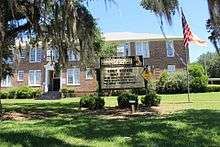 Gadsden Magnet Elementary School (former Quincy High School)
Gadsden Magnet Elementary School (former Quincy High School)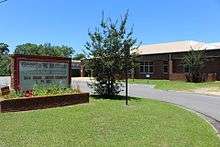 George W. Munroe Elementary School
George W. Munroe Elementary School Stewart Street Elementary School
Stewart Street Elementary School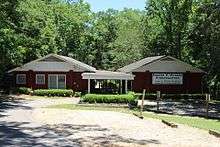 Robert F. Munroe Kindergarten (private)
Robert F. Munroe Kindergarten (private) William A. "Bill" McGill Public Library
William A. "Bill" McGill Public Library
Infrastructure
Transportation
U.S. Route 90 (Jefferson Street) is the main highway through the city; US 90 leads southeast 24 miles (39 km) to Tallahassee and northwest 19 miles (31 km) to Chattahoochee. The city limits extend south to beyond Interstate 10, which passes 3 miles (5 km) south of the center of the city. I-10 leads east 22 miles (35 km) to Tallahassee and west 170 miles (270 km) to Pensacola. Other highways in Quincy include SR 12, which leads 12 miles (19 km) to Havana and southwest 28 miles (45 km) to Bristol; SR 267, which leads north 8 miles (13 km) to the Georgia line and south 8 miles to Wetumpka; and SR 268, which leads southeast 11 miles (18 km) to Midway.
Quincy Municipal Airport is a public-use airport located 2 miles (3.2 km) northeast of the central business district. Gadsden express bus travels to and from quincy Tallahassee
Notable people
- Nat Adderley Jr. (b. 1955), music arranger who spent much of his career with Luther Vandross[29]
- The Lady Chablis (1957-2016), born Benjamin Edward Knox,[30] transgender entertainer best known for her appearance in the book and subsequent movie adaptation of Midnight in the Garden of Good and Evil
- Lillian Cox (1907-2018), American supercenterian
- Elizabeth Whitfield Croom Bellamy (1837-1900), writer
- Billy Dean (b. 1962), country music singer
- Dexter Jackson (b. 1977), American football player and Super Bowl XXXVII MVP
- Jerrie Mock (1925-2014), first woman to fly solo around the world
- Willie Simmons(b.1980), coach at Florida A&M 2018
Coca-Cola
Quincy investors were largely responsible for the development of its local Coca-Cola company into a worldwide conglomerate. Quincy was once rumored to be home to many millionaires due to the Coca-Cola boom. Mr. Pat Munroe, a banker, father of 18 children from two wives, and W.C. Bradley were among the stockholders of three of the banks that released 500,000 shares of new Coca-Cola common stock. They urged widows and farmers to invest for $40 each and several did.[31][32][33][34][35] Eventually that stock split, and made as many as 67 accounted for investors and Gadsden County residents rich. In perspective, a single share of Coca-Cola stock bought in 1919 for $40 would be worth $6.4 million today, if all dividends had been reinvested.[8]
Gallery
 Downtown Quincy on US90
Downtown Quincy on US90 Police department
Police department Quincy Fire Department
Quincy Fire Department Joseph L. Ferolito Recreation Center
Joseph L. Ferolito Recreation Center Quincy Post Office
Quincy Post Office
References
- ↑ "The City of Quincy Florida Website". The City of Quincy Florida Website. Retrieved September 21, 2012.
- ↑ "2016 U.S. Gazetteer Files". United States Census Bureau. Retrieved Jul 7, 2017.
- 1 2 "Population and Housing Unit Estimates". Retrieved June 9, 2017.
- 1 2 "American FactFinder". United States Census Bureau. Archived from the original on September 11, 2013. Retrieved 2008-01-31.
- ↑ "US Board on Geographic Names". United States Geological Survey. 2007-10-25. Retrieved 2008-01-31.
- 1 2 "Geographic Identifiers: 2010 Demographic Profile Data (G001): Quincy city, Florida". American Factfinder. U.S. Census Bureau. Retrieved November 21, 2016.
- ↑ "Find a County". National Association of Counties. Archived from the original on May 31, 2011. Retrieved 2011-06-07.
- 1 2 3 "Profile for Quincy, Florida, FL". ePodunk. Retrieved July 16, 2016.
- ↑ State Library and Archives of Florida. "Florida Memory - Workers harvesting wrapper tobacco - Quincy, Florida". Florida Memory.
- ↑ Hobbs, Tameka Bradley. ""Hitler Is Here": Lynching in Florida during the Era of World War II". Retrieved 30 November 2017.
- ↑ Hobbs, Tameka. Democracy Abroad, Lynching at Home: Racial Violence in Florida. ISBN 9780813062396.
- ↑ Ortiz, Paul. "African-American Resistance to Jim Crow in the South".
- ↑ Granade, Ray (July 1976). "Slave Unrest in Florida" (PDF). Florida Historical Quarterly: 18–36.
- ↑ "Archived copy" (PDF). Archived from the original (PDF) on November 4, 2013. Retrieved November 1, 2013.
- 1 2 "AIDS: A Community Fights Back". WCTV. February 19, 2004. Retrieved November 19, 2016.
- ↑
- ↑ https://khn.org/morning-breakout/dr00015669. Missing or empty
|title=(help) - ↑ "Archived copy" (PDF). Archived from the original (PDF) on May 22, 2013. Retrieved June 23, 2013.
- ↑ "US Gazetteer files: 2010, 2000, and 1990". United States Census Bureau. 2011-02-12. Retrieved 2011-04-23.
- ↑ "Weatherbase: Historical Weather for Quincy, Florida". Weatherbase. 2011. Retrieved on November 24, 2011.
- ↑ "Census of Population and Housing". Census.gov. Archived from the original on May 12, 2015. Retrieved June 4, 2015.
- ↑ "Gadsden Arts Center & Museum > Home". www.gadsdenarts.org.
- ↑ "Archived copy". Archived from the original on 2016-03-14. Retrieved 2016-03-09.
- ↑ Quincy Music Theatre. Cinema Treasures. Accessed 2013-03-04.
- ↑ Miller, Brian (2017-01-30). "Striplin goes from West Gadsden to East, schools likely to consolidate". Tallahassee Democrat. Retrieved 2017-04-05.
- ↑ Jiwanmall, Stephen (2017-04-04). "Gadsden County Schools to Consolidate in 2017-18". WTXL. Retrieved 2017-04-06.
- ↑ "Robert F. Munroe Day School 91 Old Mt. Pleasant Road Quincy, Florida 32352" and "Robert F. Munroe Day Kindergarten 1800 West King Street Quincy, Florida 32351"
- ↑ "About Us." Robert F. Munroe Day School. Retrieved on June 5, 2017. "Founded in 1969 in Mt. Pleasant, Florida, the campus[...]" and "91 Old Mt. Pleasant Rd. Quincy FL, 32352"
- ↑ Stewart, Zan. "Born to swing: Nat Adderley Jr. returns to his roots", The Star-Ledger, September 10, 2009. Accessed September 10, 2009.
- ↑ The Lady Chablis Sassy Transgender Figure in Savannah Book, Movie Dies at-59." Washington Post, Sept. 9, 2016. Retrieved on Sept. 12, 2016.
- ↑ "Archived copy" (PDF). Archived from the original (PDF) on April 18, 2014. Retrieved June 22, 2013.
- ↑ Gary McKechnie. "The Coca-Cola Millionaires of Quincy, Florida". visitflorida.com.
- ↑ "Quincy's Drink of Choice". tallahasseemagazine.com.
- ↑ "Quincy Florida: America's Coke Habit Made The Town Rich". Florida Backroads Travel.
- ↑ "Quincy Fl Coca Cola History - Coke millions fortify a town Shareholders: The Coca-Cola stock that some Quincy, Fla., tobacco farmers bought 74 years ago is still held today by the town's "Coke millionaires," whose generosity has made Quincy a better place to live. - tribunedigital-baltimoresun". tribunedigital-baltimoresun.
External links
| Wikimedia Commons has media related to Quincy, Florida. |
- City of Quincy official website
- Virtual Tour of Quincy
- City-Data.com, comprehensive statistical data about Quincy
